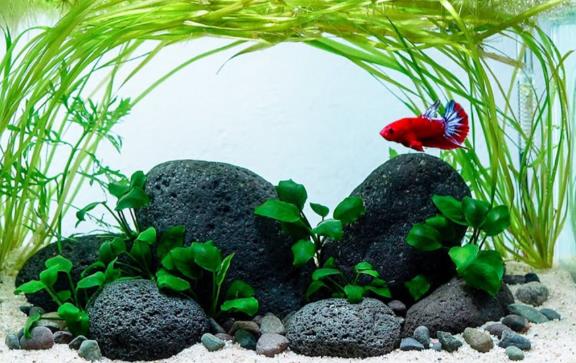Plant Types to Avoid in a Betta Fish Tank
Aquatic Plants with Thorns or Sharp Edges

Plants like Elodea, small-leaf Anubias, and Vallisneria have thorns on their leaves or stems that can easily scratch the delicate tail and pectoral fins of betta fish. These scratches may lead to infections or fin rot.
How to identify: Run your finger along the leaf edges—if you feel a distinct prickly sensation, avoid using the plant.
Invasive Aquatic Plants That Overbreed
Species such as Hornwort, Water Hyacinth, and dense-growing Moss grow extremely fast. They can take over space in the tank, consume large amounts of oxygen, and even cause bettas to suffer from oxygen deprivation or limited movement.
Example: There have been cases where Hornwort overgrew and filled the entire tank, leading to the suffocation of betta fish.
Aquatic Plants Prone to Rotting or Toxin Release
Plants like duckweed (e.g., Eichhornia crassipes) and terrestrial plants converted to aquatic use (such as Epipremnum aureum and Dracaena sanderiana) can rot and contaminate the tank water, triggering gill rot or poisoning in bettas.
Additionally, some plants (e.g., Najas marina) release inhibitory chemicals that interfere with bettas’ breathing.
Recommended Safe Plant Choices
Narrow-leaf Java Fern: Its leaves are soft and thorn-free, with a stable root system. It provides a safe hiding spot for bettas and is resistant to rotting.
Weeping Moss or Moss Balls: These should be planted sparsely and secured in place to prevent them from tangling with bettas’ fins.
Small-leaf Anubias (Broad-leaf Varieties): Features rounded, blunt leaves and helps purify tank water. Bettas enjoy swimming through its foliage.
Marimo Moss Balls: Their fluffy texture offers a resting spot for bettas, while also helping to stabilize water quality.
Tank Landscaping Precautions
Reserve Space: Ensure the water surface remains unobstructed to allow bettas to breathe and build bubble nests (a natural behavior for male bettas).
Regular Trimming: Control the density of aquatic plants and promptly remove dead or decaying leaves to maintain water cleanliness.
Prioritize “Submerged Leaves”: Avoid using terrestrial plants or wild plants of unknown species, as they may not adapt to aquatic environments and could harm bettas.
By selecting and arranging safe aquatic plants appropriately, you can not only enhance the visual appeal of the betta tank but also ensure the health and natural behavioral needs of your betta fish are met.
